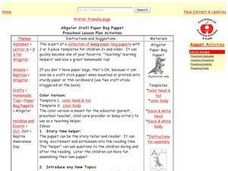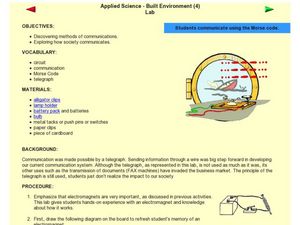Kids Can Have Fun
Cut and Paste Alligator
Who knew an alligator could have so many different looks? For this activity, youngsters choose a set of eyes out of eight choices and cut and paste them onto an alligator. They color their creatures after the eyes have been attached.
Curated OER
Alligators
Students investigate the characteristics of alligators. In this animal science lesson, students sing a song to identify the parts of an alligator. Students draw a picture of their own alligator.
August House
Go to Sleep, Gecko
Use this multidisciplinary lesson to delve into these subjects: English language arts, math, science, drama, and character education. After reading, discussing, and making interpretations about Go To Sleep, Gecko!: A Balinese Folktale by...
Curated OER
Reptiles Vocabulary Multiple Choice Activity
In this reptiles vocabulary activity, students complete a ten question multiple choice activity pertaining to reptiles. Students read the questions and choose the correct answer from four choices.
Curated OER
Aa is for Alligators
Students listen to books about alligators. In this alligators reading lesson, students recognize the letter A, in upper and lower case. Students color, or cut and color, based on skill level a picture of an alligator. Students discuss...
Curated OER
Alligator
Pupils create a model of an alligator out of clay using both artwork and research to guide their finished work.
Curated OER
A For Alligator
In this recognizing letter "Aa" words worksheet, students unscramble a word, choose multiple choice answers about alligators, create words from "alligators are reptiles", and complete a word search. Students answer 4 activities.
Cornell University
Making a Battery
Don't be shocked when your class has a blast making their own batteries! Science scholars examine a dry cell battery, then design and construct a wet cell battery. The activity guides them through the parts of a battery, the variables...
It's About Time
Adaptations
Congratulations! You exist, thanks to the wonders of biology and adaptations. The focus of the lesson explains many adaptations of plants and animals and how the environment has influenced the process. A hands-on activity demonstrates...
Curated OER
Alligator Craft Paper Bag Puppet
Students make paper bag puppets. They use the puppets as a story teller and reader. Students use the puppets to ask questions during and after reading. They assemble their own puppet. Students use the puppets to introduce new themes,...
Teach Engineering
Force on a Current Carrying Wire
What do electrical currents have to do with an MRI? Using a simple wire setup and a magnet, class members explore forces used in an MRI by investigating the magnetic force acting on a wire carrying a current.
Colorado State University
How Can You Demonstrate the Different Efficiencies of Different Light Bulbs?
Need a bright idea for an engaging lab? Watch your class light up as they explore the difference in efficiency between incandescent and LED bulbs! The resource makes use of simple materials and encourages learners to infer what's...
Curated OER
Croc or Gator?
Students study the similarities and differences between crocodiles and alligators using online information. They develop a Venn diagram based on their research.
Curated OER
Make Words Using the Letters in the Word " Alligator"
In this spelling and science worksheet, students read a short description of an alligator before using the letters in its name to make as many words as possible. They are encouraged to make at least 18 words which they can check with...
Curated OER
Nocturnal Animals Cloze Activity
In this science cloze activity, 3rd graders fill in the 9 blanks in a selection about nocturnal animals. They use the words from a word bank at the bottom of the page to complete the paragraph. They cut out pictures of nocturnal animals...
Curated OER
Picture Scramble: Manatee, American Alligator, Brown Pelican
In this science and visual discrimination worksheet, students examine images of a manatee, American alligator and brown pelican. Next to each picture is the same image which has been divided into 9 pieces and scrambled. Students place...
Curated OER
Communication Methods
Students explore communications by participating in a science class activity. In this communication technology lesson plan, students discuss the process of morse code, its history, and the electromagnets used to create the device....
Curated OER
Electrical Circuits
Students compare series and parallel circuits. In this electricity and circuits lesson, students roleplay as a "wire" passing an energy ball to demonstrate how a series circuit works and how the circuit can be broken. Students construct...
Cornell University
Build a Fuel Cell
Discover the connection between redox reactions and fuel cells. Collaborative groups build a Hoffmann Apparatus that demonstrates the electrolysis of water and then convert their models into a fuel cell. They use their fuel cells to...
Curated OER
Crawdad Grab
Students explore biology by conducting a freshwater fishing activity. In this crawdad activity, students discuss what a crawdad is, where they are found and how they can be prepared as a meal. Students utilize string, alligator clips,...
Curated OER
Introduction to Photovoltaic Systems
The Green Education Foundation found that this lesson plan, written by the Texas State Energy Conservation Office, is right up their alley when it comes to teaching sustainability. It is ideal as a first lesson plan on photovoltaic...
Curated OER
The Shocking Truth About Fruit
Looking for a great lesson plan on circuits and conductors of electricity? Take a look at this one! In it, 6th graders create circuits out of pennies, washers, alligator clips, fruit, and LED’s. Learners use voltmeters to analyze the...
Exploratorium
Sound Bite
Learners use their teeth for more than just eating. The activity shows class members how to send sound through their teeth by using an electric motor connected to a radio to generate vibrations. Biting on the motor transfers the...
Curated OER
On The Light Side
Kindergartners identify different sources of light in a science activity. They view pictures of a flashlight, a match, and a lamp, among others, and color the part of the picture that creates light. A science activity prompts them to...

























